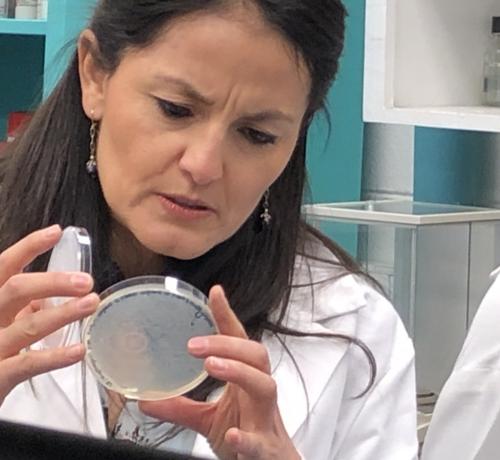 |
| Paola Mera, NMSU assistant professor of chemistry and biochemistry, received a $1.5 million grant from the National Institutes of Health to research antibiotic resistance. (NMSU photo by Minerva Baumann) |
Antibiotic resistance is one of the biggest health challenges of our time, according to the World Health Organization and the U.S. Centers for Disease Control and Prevention. The CDC reports more than two million people in the U.S. get an antibiotic-resistant infection each year and about 23,000 die.
New Mexico State University professor Paola Mera’s research received a $1.5 million, five-year grant from the National Institutes of Health to fund the equipment and manpower that will help her research put us on the path to addressing the problem of antibiotic-resistance.
“Antibiotic resistance is a big problem because the numbers of people with infections from bacteria we can’t treat keep increasing,” said Mera, an assistant professor of biochemistry in the College of Arts and Sciences. “What this project is going to do is identify new targets that will help others design new antibiotics so we can control the growth of antibiotic resistant bacteria.”
Bacteria grow so fast they can grow from one cell to billions in less than a day. Mera’s approach is to find out how bacteria maintain their genetic information (chromosome) intact after every cell division while growing so fast.
“To visualize how the bacterial cell looks, imagine a ball of yarn all fluffy and nice. Those are the chromosomes. They are a long string of DNA packed super tight and coiled so that they fit inside a tiny ball bearing,” Mera explained. “The cell has to make a copy of that chromosome in a ridiculously packed space by first unraveling that ‘ball of yarn,’ making a copy of it, repacking it and then moving it away into the new cell as it divides. It’s incredible how bacteria manage to do all that so quickly over and over again without getting tangled up.”
Mera’s goal is to understand how those steps are regulated and her team already has made a discovery pointing her in the direction to learn more.
 |
| Paola Mera, assistant professor of chemistry and biochemistry, discusses bacteria research with lab manager and research scientist Inoka Meikpurage and NMSU senior and genetics major Rawan Elaksher. (NMSU photo by Minerva Baumann) |
“We have exciting data that show the molecular machines that are involved in copying the bacteria’s chromosome and the machines involved in moving the chromosomes away from each other are talking to each other,” Mera said. “And they’re talking not only in one direction, but they’re talking in two directions.”
If Mera’s research group can decode the mechanisms involved in this communication between key regulators of the chromosome, they can identify targets to support the design of new drugs that interrupt bacteria’s process of copying itself and perhaps slow or even stop its growth.
“What we’re trying to do is understand the fundamental mechanisms so we can design drugs that inhibit bad bacteria,” Mera said. “But once we identify these mechanisms, we may also use this research to develop drugs to promote growth of good bacteria.”
For the next few years, Mera and her team of student researchers will work on discovering the regulation of two essential processes ¬– replication and segregation of the chromosome.
“My goal at the end of five years is that we would have a more detailed picture of this signaling process so we can really target where we can inhibit the communication.”
Mera’s grant will allow her lab to purchase all the necessary state-of-the-art instrumentation to conduct experiments. She has already hired a lab manager and has a research scientist but wants to recruit additional graduate researchers to work along with the students who have already been involved.
“At this point, I have one Ph.D. student and five undergraduate students in addition to my lab scientist and lab manager,” Mera said. “The research done by my students is critical. One of my students, Rawan (Elaksher), joined in the last part of her freshman year. Now she’s a senior and she’s really like a graduate student, working on projects independently. It’s been nice to see her grow as a scientist.”